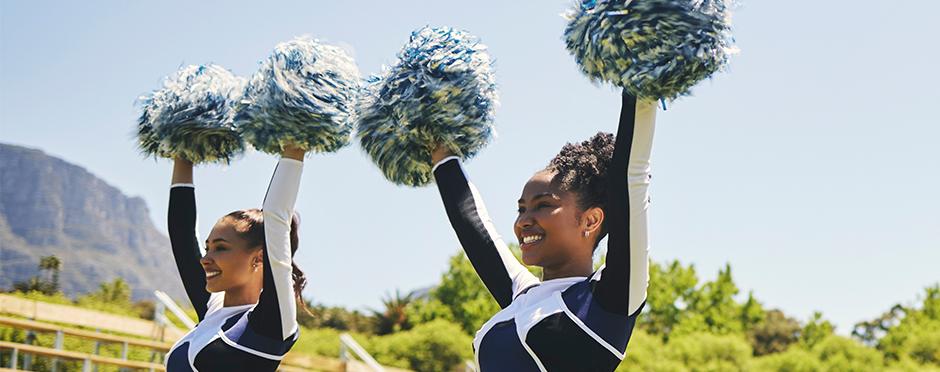
Returning to Cheerleading After a Concussion
Leave a CommentCheerleading is a competitive, fun, and popular sport for many ages. Competitive cheerleading can start as young as five years old and continue through collegiate levels. Most school affiliated cheer teams begin in middle or high school. Cheerleaders are often divided into two main categories based on which skills they perform: flyers and bases. Flyers are the athletes who are lifted or tossed into the air or on the top of stunts. Bases are the athletes who perform the lifting or toss, and they catch the flyers. Both flyers and bases perform tumbling passes.
The risk of suffering a concussion in cheerleading has increased in recent years, similar to other sports. This may be due to an increased awareness and reporting of concussions in general. However, in cheerleading, the concussion rate has increased while the sport’s overall injury rate has decreased1. Concussions are the most common head injury in cheerleading, and 96% of concussions are secondary to a stunt-related incident1. A higher rate of concussions was found to occur during practice rather than during competitions1.
How Do Concussions Occur in Cheerleading?
- A flyer falls from a stunt and hits their head on a hard surface.
- A flyer falls from a stunt and hits another athlete, such as a base- in which case either athlete could sustain a concussion.
- A collision with another athlete
Concussion Symptoms
Any one or more of the following signs and symptoms may indicate a head injury:
- Headache
- Nausea or vomiting
- Dizziness
- Coordination or balance issues
- Blurred or double vision
- Light or noise sensitivity
- Feelings of sluggishness
- Memory or concentration problems
- Altered sleep patterns
Signs observed by coaches or other team members that may indicate a concussion has occurred:
- Stunned or confused appearance
- Forgetfulness
- Confusion about routines
- Unsure of surroundings
- Inability to name current venue, date, or time
- Clumsy movements
- Loss of consciousness (long or short)
- Personality or behavior changes
- Forgetful of events right before or after a blow to the head
Protocol for After Concussion
If a concussion is suspected, the athlete should not return to practice or competition until at least 24 hours after the incident and after a physician clears them. In the first 24-48 hours, try to go about your normal daily activities, but if your symptoms increase, stop doing that activity, such as reading, watching TV, or playing video games. Generally, physical rest is recommended initially. After this initial rest, a gradual return to normal daily activities and light exercise have been shown to help with recovery.
Return to Cheer After Concussion
There are many different considerations for returning to your sport after a concussion. Physical therapy for concussions can include the management of neck pain, and headaches, introduction to balance retraining, cardiovascular activities, and vision retraining. Cheerleaders have an added consideration with tumbling and stunting tasks with their return to sport.
In general, cheerleaders should progress slowly with a return to sports activities. New activities should be introduced every 24 hours to assess symptoms. A general guideline is as follows:
Phase 1: no activity- cognitive and physical rest
Phase 2: limited activity- stretching, non-impact cardio for 15-20 minutes
Phase 3: low-risk cheer specifics- no flipping, no inversions, for example, leaps, jumps, basic cheer moves
Phase 4: high-risk cheer specifics- basic flipping and tumbling
Phase 5: skill progression, higher difficulty flipping, gradual increase in tumbling, begin running partial routines with a gradual return to full routines and all skills.
Full return to participation should be based on the following:
- Symptom resolution
- Tolerance of academic work
- Completing an exertion protocol
- Clearance by the treating physician
Tips to Prevent Concussions in Cheerleaders
- Ensure proper mats and equipment setup
- Always have trained spotters in place at practice and competition
- Instruct athletes in proper technique
- Ensure athletes pay attention during practice to prevent collisions or distractions
In the effort to prevent and properly identify concussions, it is important to provide education to coaches and parents on identifying the signs and symptoms. If you have questions about concussion prevention or believe that you or your athlete has sustained a concussion, connect with our team for support.
Find a Gymnastics/Cheerleading Specialist Near You
The Athletico blog is an educational resource written by Athletico employees. Athletico bloggers are licensed professionals who abide by the code of ethics outlined by their respective professional associations. The content published in blog posts represents the opinion of the individual author based on their expertise and experience. The content provided in this blog is for informational purposes only, does not constitute medical advice and should not be relied on for making personal health decisions.
Sources:
Xu AL, Beck JJ, Sweeney EA, Severson MN, Page AS, Lee RJ. Understanding the Cheerleader as an Orthopaedic Patient: An Evidence-Based Review of the Literature. Orthop J Sports Med. 2022 Jan 18;10(1):23259671211067222. doi: 10.1177/23259671211067222. PMID: 35083360; PMCID: PMC8785319.
